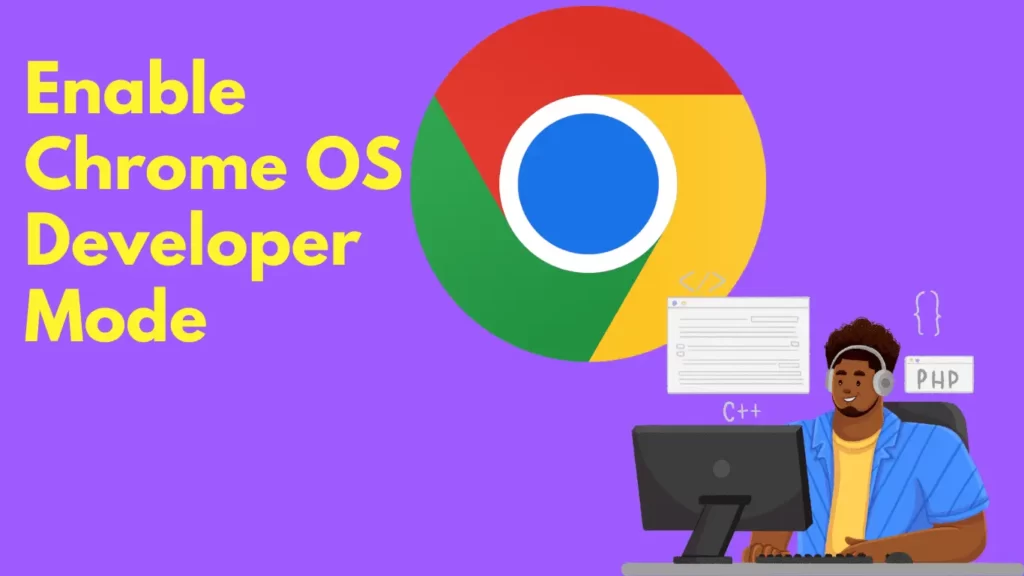
Chrome OS devices offer a great PC experience to the users. Users can go through the Chrome OS Developer Mode to unlock their full potential. If you’re searching to extend your device’s capabilities beyond the basics, this post assists you with the whole process.
In this article, we are going to outline the easy steps to enable Developer Mode on your Chromebook and provide essential insights to keep in mind during the process.
Note: It’s crucial to know that Developer Mode grants access to unofficial features, so thorough research is advised. Remember that experimenting with unsupported functionalities may lead to software or hardware issues, and the responsibility lies solely with the user.
Table of Contents
Understanding What Exactly Chrome OS Developer Mode Is?
Chrome OS Developer Mode provides users with a great experience, which is similar to having root access on an Android device.
Chrome OS Developer Mode empowers Chromebook users who love to enjoy customizing their devices by granting more control over the system.
However, Developer Mode comes with certain limitations and disadvantages, which makes it a choice suitable for those seeking to explore advanced functionalities.
Additionally, it is the best option for those users who want to sideload Android apps or install alternative operating systems on their Chromebooks.
How To Turn On Chrome Os Developer Mode?
This process is like a factory reset. So before proceeding, please ensure you’ve backed up essential files, as once you enable Developer Mode on Chrome OS, it erases all your local data. Below are the steps:
Step 1: Press and hold Esc + Refresh, then press the power button.
Step 2: Navigate to Advanced options using the arrow keys and press enter.
Step 3: Highlight Enable developer mode and press enter.
Step 4: Press enter on Confirm.
Step 5: Some Chromebooks may need OS verification off. Press Enter if required.
Step 6: The device restarts, showing “You are in developer mode.”
Step 7: Highlight the Boot from the internal disk and press enter.
Step 8: Wait for the restart; transitioning to Developer Mode takes time.
Step 9: See the “You are in developer mode” screen on boot again.
Step 10: Highlight Boot from the internal disk and press enter (yes, again).
Step 11: Once you’ve done and ready, proceed with the Chromebook setup process.
Read Also: Exploring The 7 Best AI Code Generator Tools For Programmers
How Do I Disable Chrome OS Developer Mode?
Disabling Chrome OS Developer Mode is a straightforward process, though it requires time and erases your whole data, so ensure you’ve backed up your data.
Step 1: After restarting your Chromebook, you’ll see the “You are in developer mode” screen.
Step 2: Navigate to “Return to secure mode” using the arrow keys and confirm by pressing enter.
Step 3: The Chromebook will power off, initiating the transition from Developer Mode to Secure Mode.
Step 4: After restarting, you’ll be prompted with the setup process.
What Are The Disadvantages Of Enabling Developer Mode?
Enabling Developer Mode offers distinct advantages, but it’s not tailored for the average user, requiring a certain level of technical proficiency. There are numerous disadvantages to enabling developer mode, including:
- Google doesn’t provide support for Developer Mode, which can create risk for your device’s warranty.
- Moreover, security features are entirely disabled, which can expose your device to potential vulnerabilities.
- A notable drawback is the loss of local data during the enabling or disabling process, with a higher risk when deactivating it.
- Accidental keystrokes, particularly the Spacebar, can result in data loss, underscoring the importance of continuous backups for critical work.
- Additionally, the swift boot-up features of Chromebooks diminish in Developer Mode.
- Instead, users are confronted with a warning screen whenever they power on the device, disrupting the previously seamless startup experience.
Read Also: YouTube Activation Code Guide: How Do I Activate YouTube With TV Code
How To Enable Developer Mode On A School Chromebook?
Enabling Developer Mode on a school Chromebook is not advised without proper permission.
The process involves disassembling the Chromebook, disconnecting the battery, and pressing the power button for 30 seconds.
Following these steps may still encounter a software lock, making bypassing administrative restrictions challenging.
Additionally, altering the Chromebook’s configuration may lead to consequences if it cannot be restored to its original state. It’s crucial to proceed with caution and adhere to school policies.
Conclusion
Through this article, we’ve told you the procedure for how you can turn on Chrome OS Developer Mode. Along with this, we have also explained in detail how to disable it and what its disadvantages can be. We hope that you liked this article, if yes! Then please share it with your friends.
Frequently Asked Questions
Q. How can I enable verified access on my Chromebook?
Ans: To enable verified access for users, navigate to the Users & Browsers section under Devices>Chrome>Settings and adjust the setting to “Require verified mode boot for verified access.”
Q. Is Developer Mode safe on a Chromebook?
Ans: Developer Mode poses inherent risks, often requiring OS verification disabling. It should only be utilized if you are confident in understanding its implications.
Q. How do I install an APK file without enabling Developer Mode on a Chromebook?
Ans: Without Developer Mode, you can install an APK by setting up Linux on your Chromebook, configuring ADB, and tapping the Build number in the About device section within your Android preferences.
Q. Does turning on developer mode delete everything from Chromebook?
Ans: Yes, enabling Developer Mode results in the deletion of all locally stored data, and it cannot be recovered.






